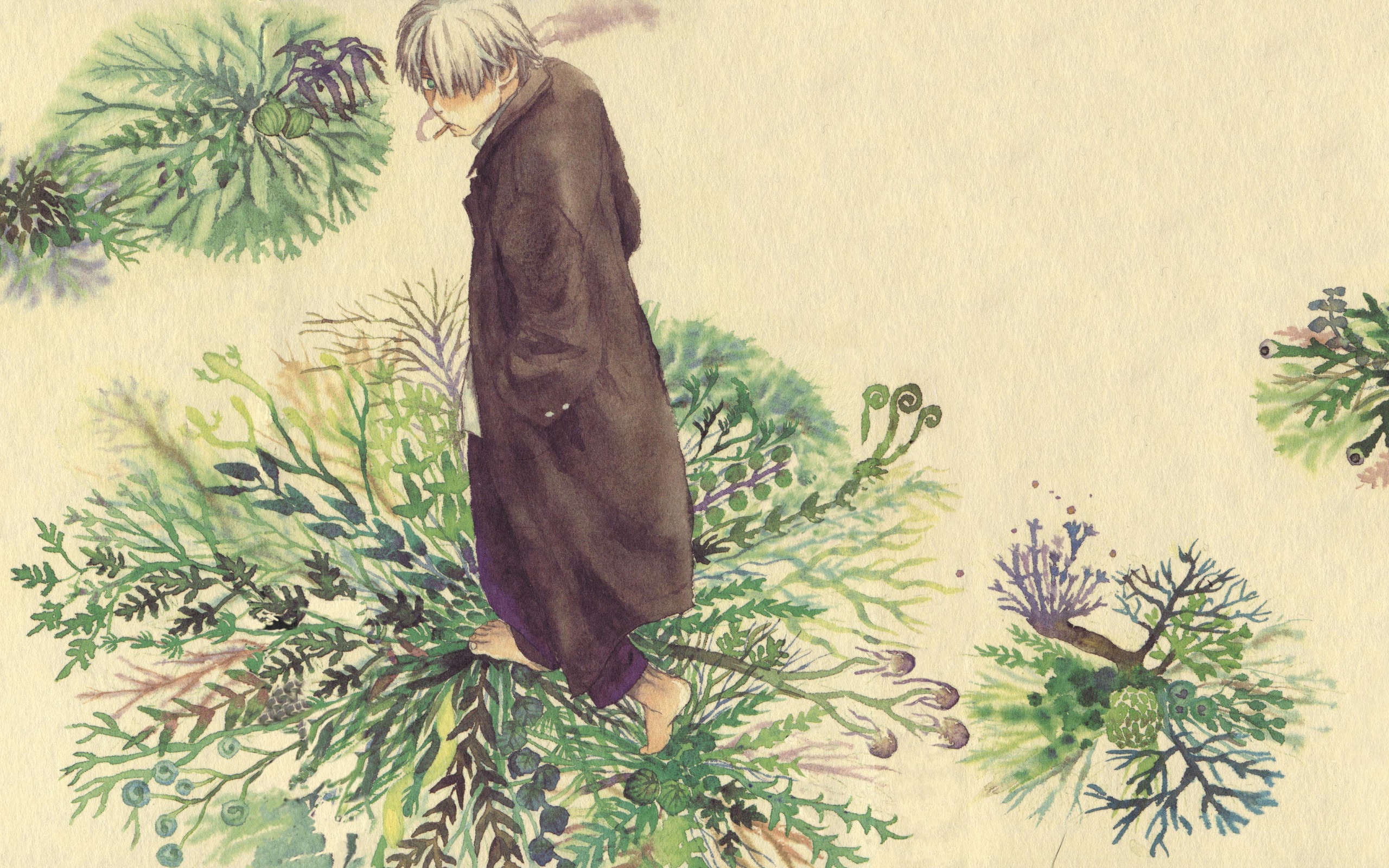Table of Contents Show
Media has the power to influence society, as well as reflect it. Throughout Japanese history, manga and anime has been used to explore different perspectives of current events of the times they were published. Post World War II manga and anime often reflect Japan’s rapidly changing political and social climate, including changing gender roles, rising materialism, and the commodification of daily life. Yuki Urushibara’s manga Mushishi is a critically acclaimed series that addresses most of these internal issues.
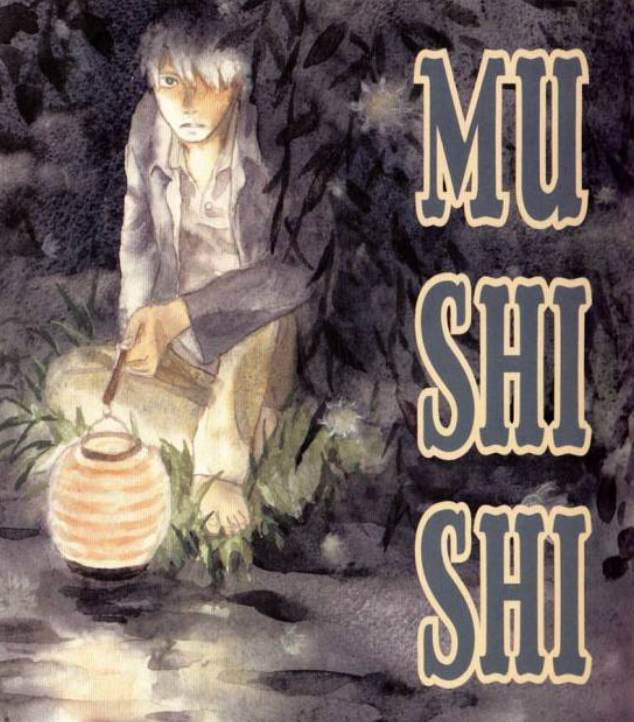
Although written between the late 90s and early 2000s, the series gives insight into sentiments regarding large socio-political and economic changes. Throughout Mushishi, people’s daily interactions with small bug-like spirit creatures called Mushi to exemplify a nostalgia and longing for a perceived past connection to the natural world. Character’s relationships with these creatures also explore the fears, anxieties, and awe surrounding increasing commodification and modernization during late 20th century Japanese society.
What Is Mushishi?
Mushishi is an episodic anthology manga of the seinen genre that was serialized in Afternoon Seasons Zōkan between 1999 and 2002 and then in Monthly Afternoon between 2002 to 2008. The manga follows a wandering Mushi-shi (Mushi Master) named Ginko throughout the Japanese countryside during an unknown time period, hypothesized to be either during the Sakoku period (( Mio Bryce and Amy Plumb, “Mushishi: Post Modern Representation of Otherness in and outside Human Bodies,” The International Journal of Humanities, 9, no. 11 (2012): 112. )) (seventeenth century forced isolation) or the 1890s, right before the start of the Meiji Restoration (( Kevin Cooley, “Past the End of the Catbus Line: Mushishi’s Apparitional Actants,” animation: an interdisciplinary journal, 14, no. 3 (2019): 178-190. )).
Ginko is a white-haired, green-eyed man who is the only recurring character, and the only one who wears Western-style clothing. As a Mushi Master, Ginko travels between different places trying to mediate incidents between Mushi and the people they affect — through disease, natural disasters, and mysterious, sometimes fantastical events.
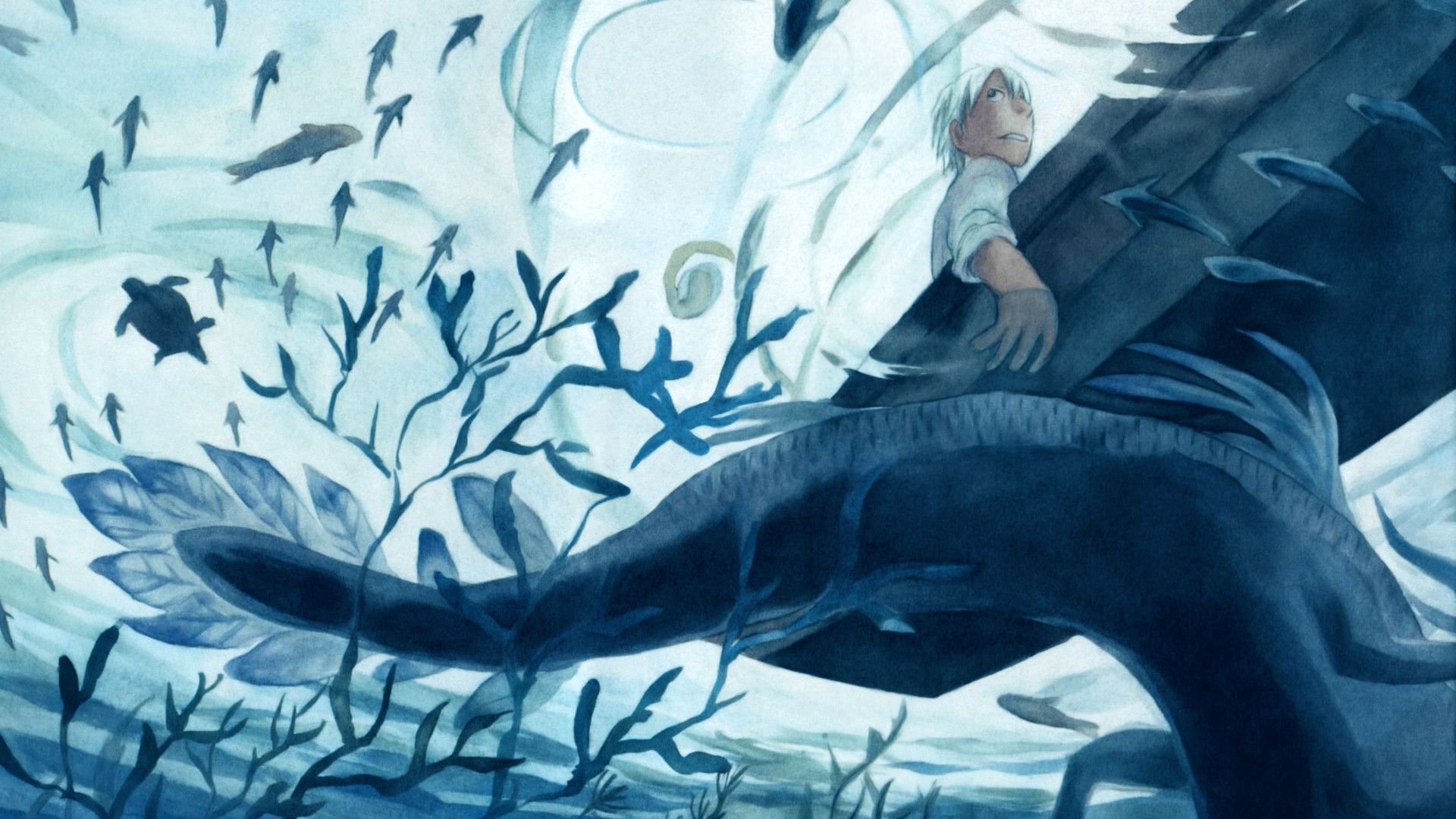
‘Mushi,’ literally translated, means bug or insect. However, the kanji used in the original Japanese version of the manga connotes something “grotesque, supernatural, or parasitical in nature (( Mio Bryce and Amy Plumb, “Mushishi: Post Modern Representation of Otherness in and outside Human Bodies,” 112. )).” Mushi are seemingly insect-like, ethereal primitive life forms that inhabit a space between the human and supernatural world but still have the power to influence human beings and their surrounding environment.
Connecting The Heart To History
In the very first chapter of the manga, “The Green Seat,” Ginko attempts to explain the relationship between humans and Mushi to a young shut-in who has the ability to bring anything he draws to life. Ginko uses his hand and forearm to show how if humans are the tip of the middle finger (farthest from the heart), then Mushis are connected to them through veins in the arm, but are right next to the heart, as they are “very close to the essence of life itself (( Yuki Urushibara, “The Green Seat,” in Mushishi Volume 1, translated by Yudan Taiteki, (New York City: Del Rey Manga, 2007), 20. )) ”.
The Mushi’s ethereal nature and nebulous place within human society lend itself to be an almost-physical representation of the fears and anxieties around the intangible changes occurring during the latter half of the 20th century in Japan. The different problems caused by the mostly invisible Mushi that Ginko encounters in the countryside can be compared to people trying to process and understand how to mediate a relationship between a new ever-changing society and their own lives.
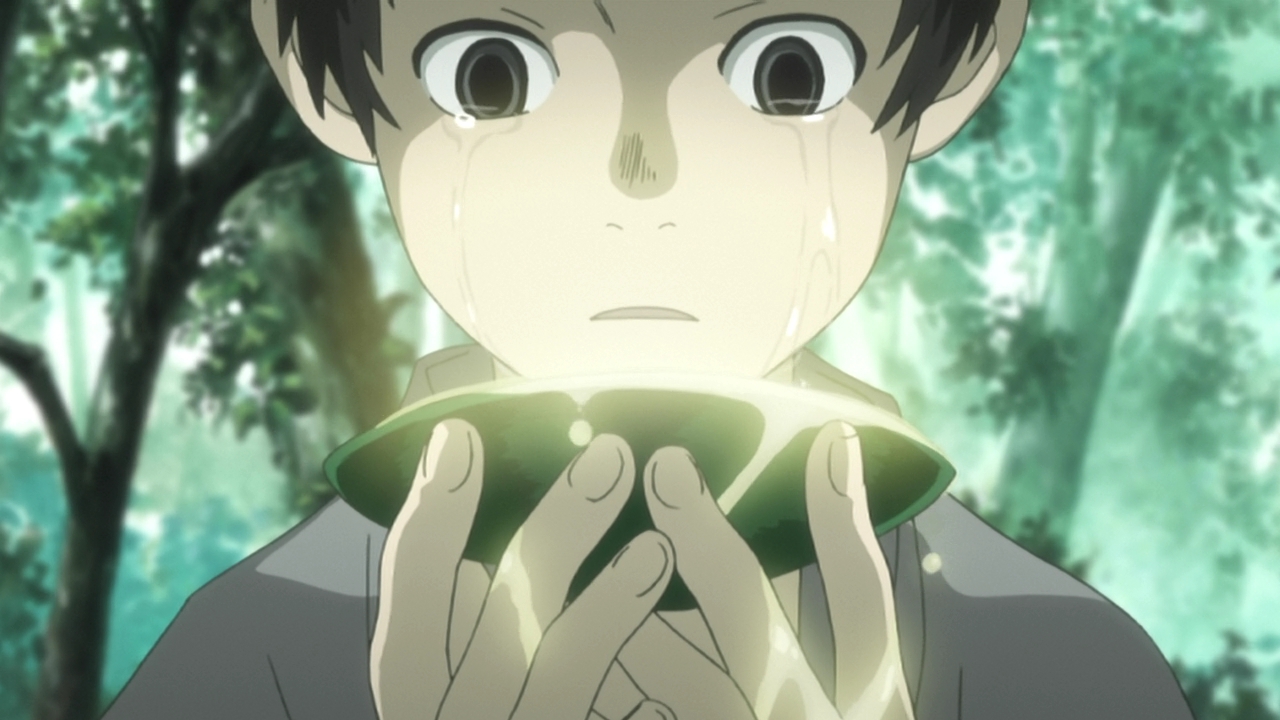
In the latter half of the 20th century, Japanese society experienced a multitude of rapid changes. In the 70s and 80s, Japan underwent several different economic and political shocks, such as an oil crisis in 1973 and 1979, and a political scandal in 1976 whose consequences were felt throughout the 80s (( Conrad, Schirokauer, David Lurie and Suzanne Gay, A Brief History of Japanese Civilization, fourth edition. (Boston: Wadsworth, 2013), 248-249. )). During these decades, affluence and consumerism also increased. More and more people moved from the countryside to the city, leading to an increase in urbanization, development, as well as pollution.
The increase in pollution throughout Japanese cities led to environmental movements in the 1980s that continued in the 1990s (( Schirokauer, Lurie and Gay, A Brief History of Japanese Civilization, 252-254. )). These changes often led people to feel unsure of the future, and in times where the present and future seem uncertain, turning to the past for answers can be a natural reaction.
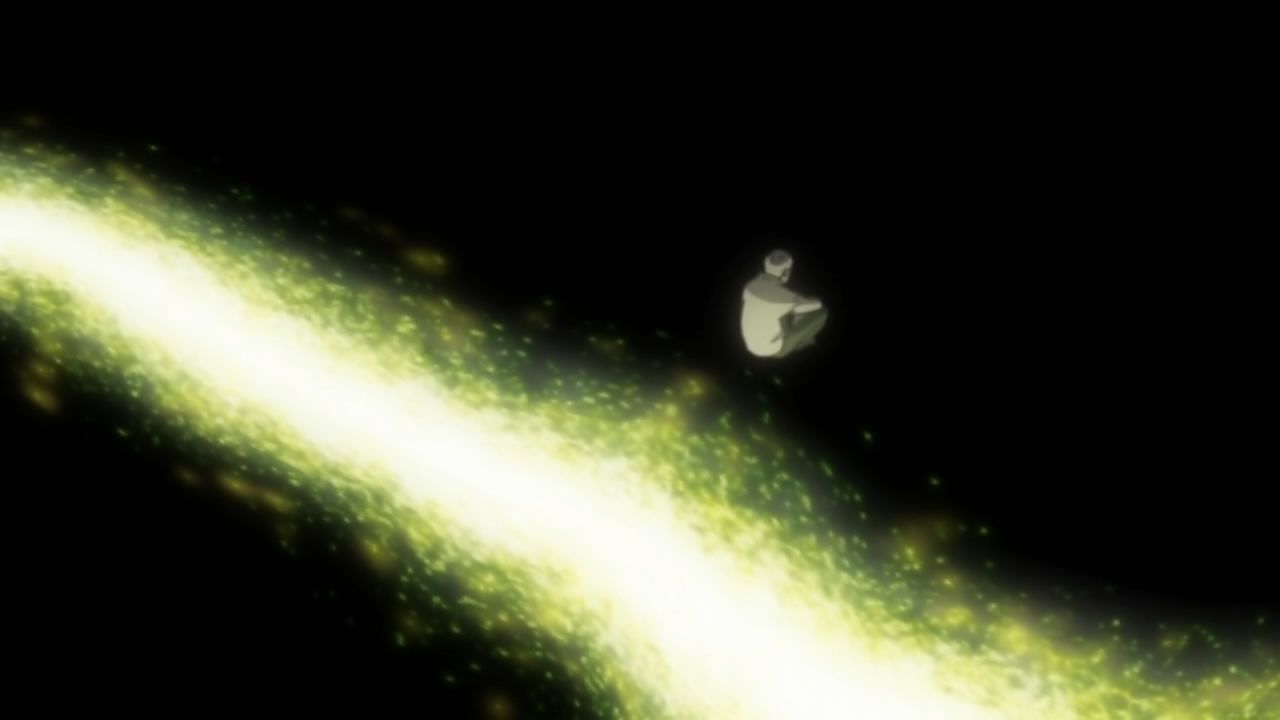
In addition, Mushishi‘s historical setting contributes to the mediation between the ongoing changes during the turn of the century Japan and its future. The simplicity of people’s surroundings and lives can be seen as a reaction to the rapid urbanization and modernization of recent decades leading up to the start of the series’ publication.
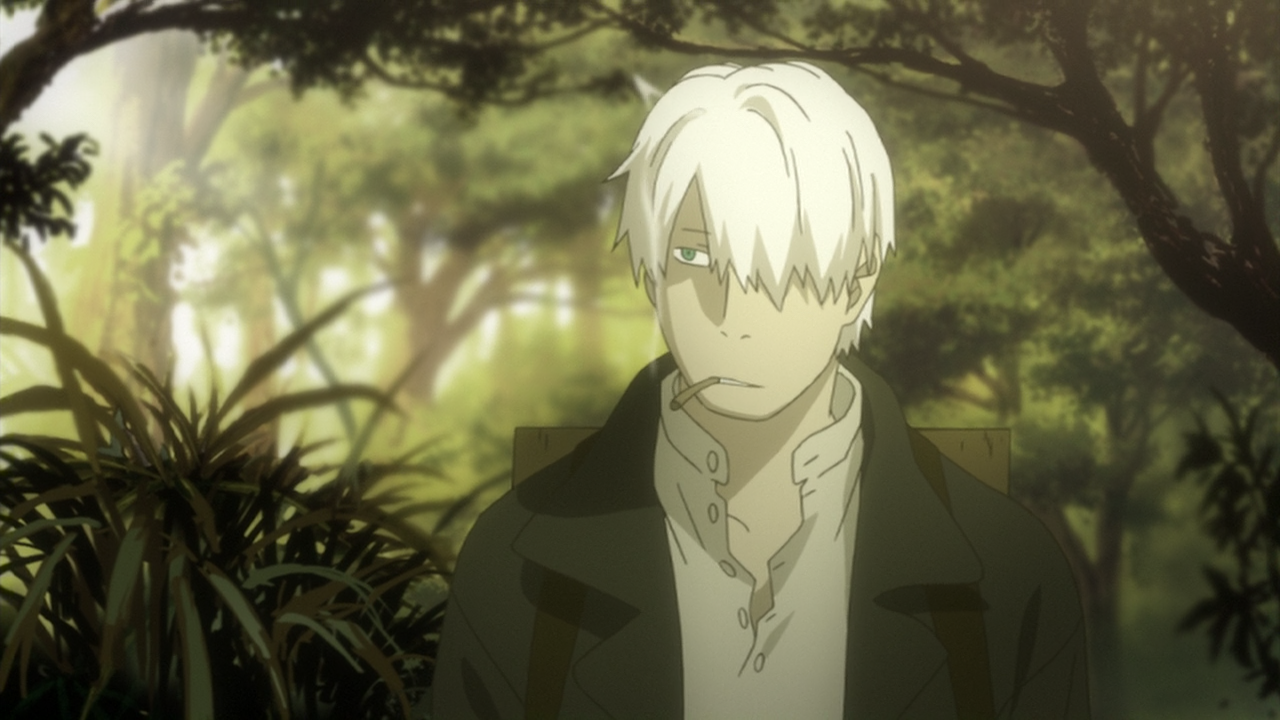
Manga is often a place where, “stressed-out modern urbanites daily work out their neuroses and their frustrations (( Frederik L. Schodt, Dreamland Japan: Writings on Modern Manga (Berkeley, California: Stone Bridge Press, 1996), 31. ))”. The simplicity, relative calmness, and connection to the natural world featured throughout Mushishi could have been a welcoming source of comfort that readers used to process their thoughts and anxieties.
Mushi And The Environment
Mushishi turns the separation from the natural world on its head through the description of the Mushi and people’s interactions with them. The way Mushi are portrayed throughout the series is a representation of, “Japanese animistic belief and mythology that perceives humans as equal to nonhumans (( Mio Bryce and Jason Davism, “Mushishi,” Resilience: A Journal of the Environmental Humanities, 2, no. 3 (Fall 2015): 135. )). Mushi are very similar to kami (god or divine being) in Shinto belief in that their nature is non-moral, ambivalent, and can have profound impacts on human life (( Paul Jackson, “The Space Between Worlds: Mushishi and Japanese Folklore,” Mechademia, 5, (2010): 342. )).
Mushishi fantasizes and dramatizes the author’s thoughts on what it means to coexist in the world with nature and other creatures. This connection juxtaposes with the growing separation between people and nature at the time the manga was published. Many of the stories told throughout the series result from people disrespecting the natural surroundings, not heeding warning signs, and interfering in the fragile balance of the ecosystem between humans and Mushi.
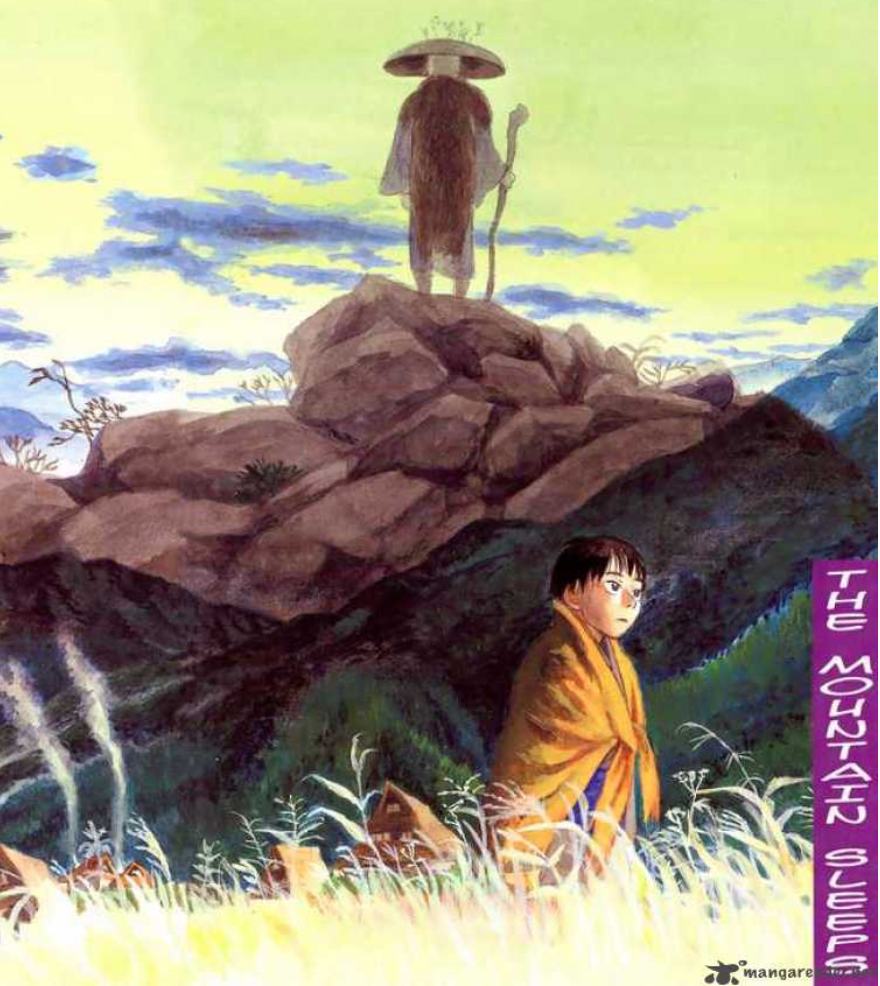
This is seen in Volume 2, Chapter 1, “The Mountain Sleeps,” when a villager kills a boar mountain god so that her beloved, a Mushi Master named Mujika, can take its place and stay with her. Mujika assumes the role of the mountain god, but as he ages, he stops being able to control the balance of the ecosystem as well as the Mushi that reside there: trees that are cut down grow back the next day, foxes with the faces of monkey are caught, and people enter the mountain forest and come back extremely sick (( Yuki Urushibara, “The Mountain Sleeps,” in Mushishi Volume 2, translated by Yudan Taiteki, (New York City: Del Rey Manga, 2008), 9. )).
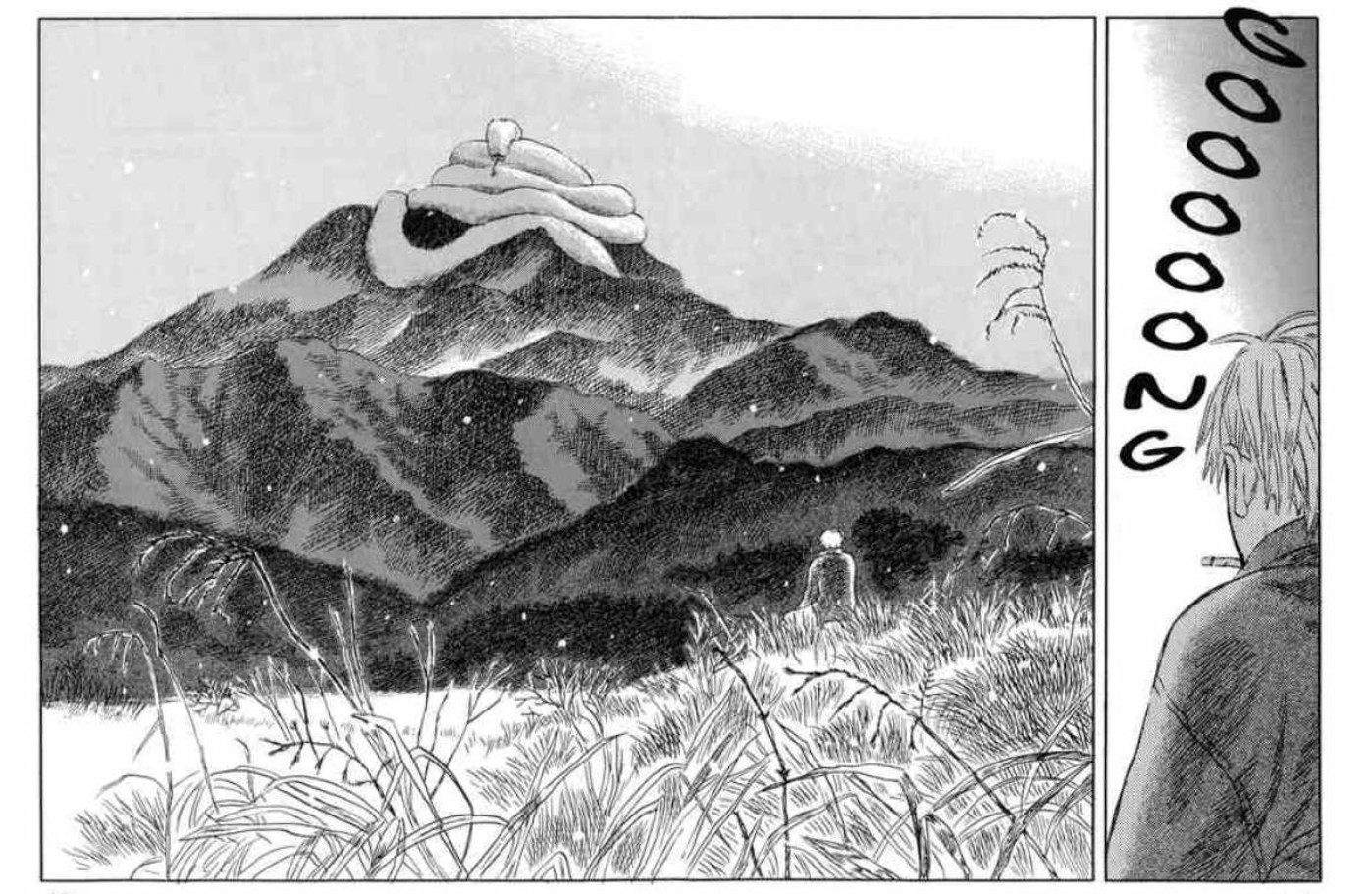
Since the villagers chose not to respect the mountain’s ushin, they have begun to pay the price. In the end, in an attempt to restore stability to the mountain, Mujika gets eaten by another Mushi called Kuchinawa (( Yuki Urushibara, “The Mountain Sleeps,” in Mushishi Volume 2, 32. )). The series’ cycle of humans trying to exert their control over nature only for it to have consequences mirrors the 20th-century environmental problems Japanese readers would have been aware of.
Natural Cycles
This cycle is seen again in Volume 6, Chapter 2, “The Chirping Shell.” In this chapter, Ginko warns the residents of a village he passes through that some disaster is imminent. He knows this from seeing small Mushi taking up residence in shells along the beach. They are called Yodokaridori, and they only come up on land to wait out disasters at sea (( Yuki Urushibara, “The Chirping Shell,” in Mushishi Volume 6, translated by William Flanagan, (New York City: Del Rey Manga, 2008), 62-63. )).
The villagers are hesitant to listen to Ginko, but they eventually do and witness a red tide wipe out all the fish in their aquaculture pens. Only by coming together to sell a pearl found by one of the diving girls and listening to nature’s warnings does everyone in the village survive the disaster. Even though, as it turns out, all the shellfish and fish in the bay were poisoned.
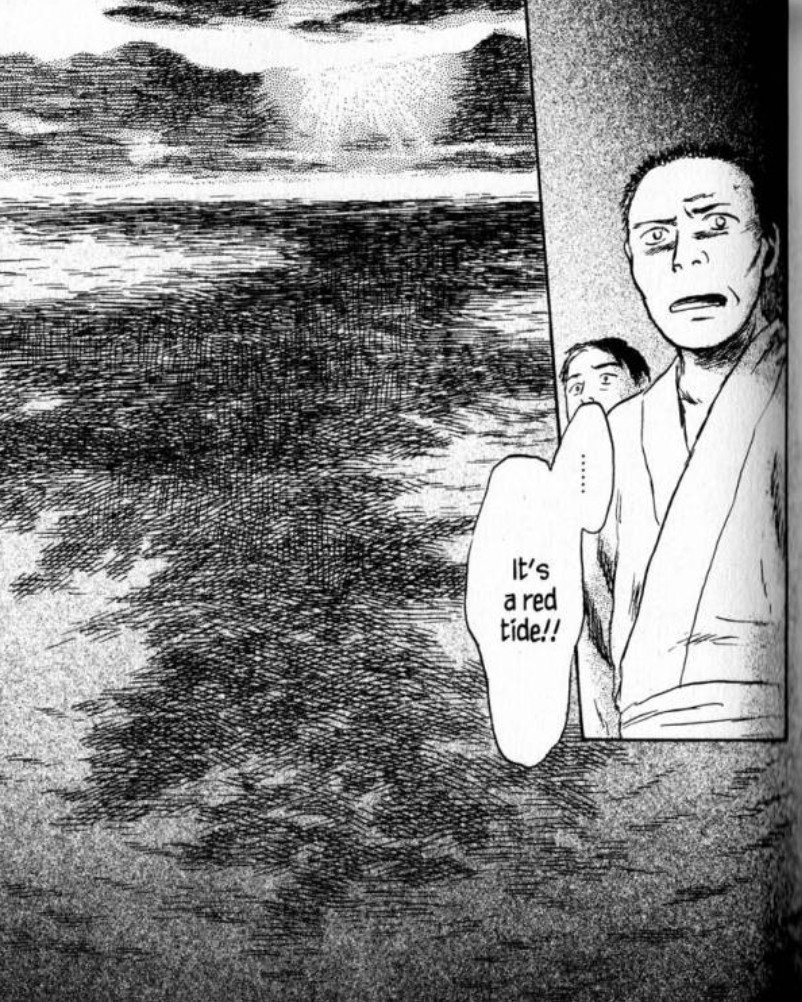
For the readers of Mushishi, seeing people come together to face a disaster is most likely a way to process recent environmental effects such as increasing pollution from cars as well as silt build up in rivers due to excess dam building (( Schirokauer, Lurie and Gay, A Brief History of Japanese Civilization, 264. )). The villagers in this chapter, as well as throughout most of the chapters in the manga, often learn to listen to the natural world around them to prevent further harm from falling on their towns.
When the villagers learn to live in harmony with the Mushi to the best of their ability, they no longer fear the unknown in their surroundings. This chapter is one of many examples throughout the series that addresses the anxieties around unpreventable but possibly foreseen disasters. If Mushishi is taken as a way for the author and readers to process their anxieties regarding the changes going on around them, nostalgia for a past when these kinds of problems could be explained and solved by a wandering master plays an important role.
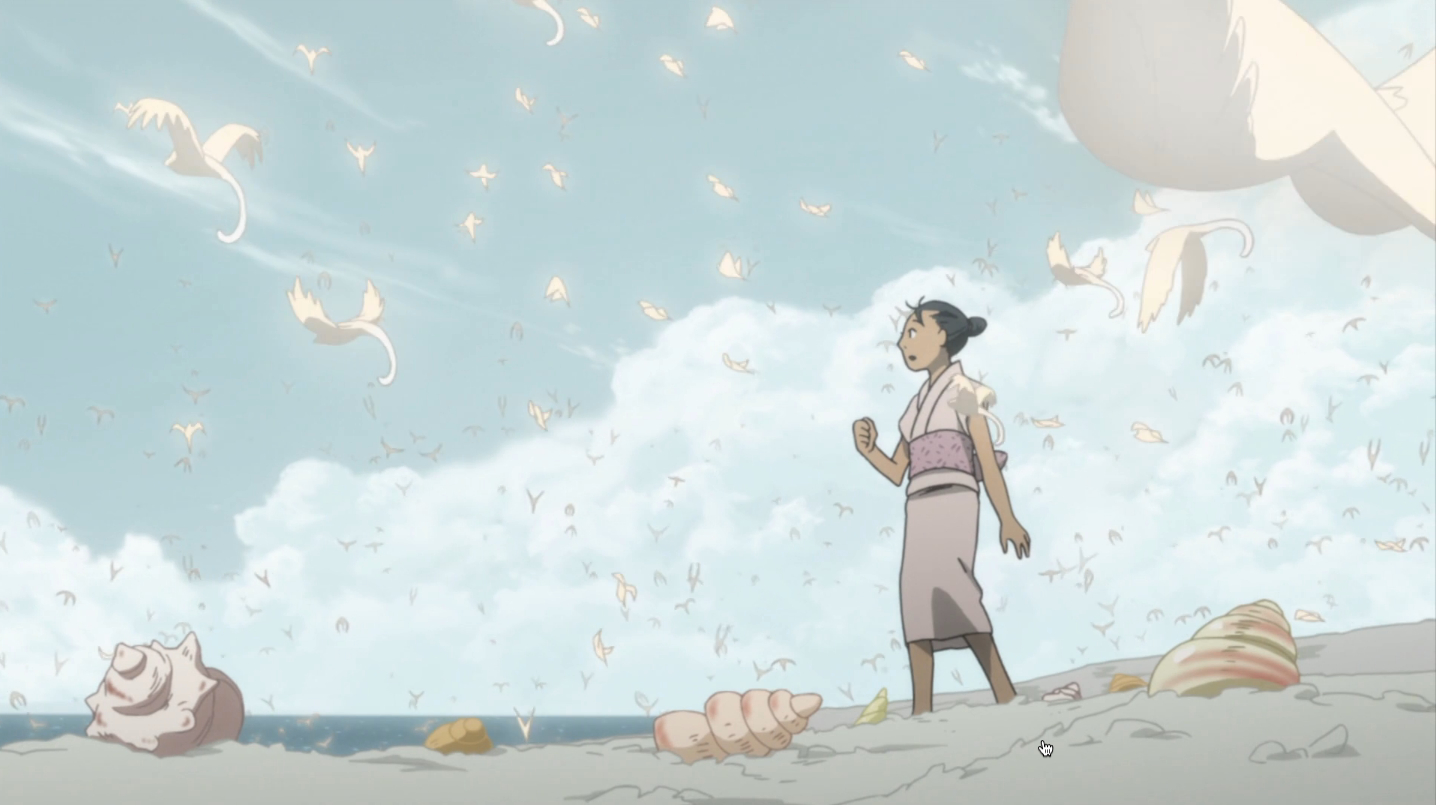
The events and characters of Mushishi are relatable to the audience since the characters also seemingly have problems they do not understand and cannot at first, or ever, control. However, many of the characters find some solace or solution through Ginko’s intervention or advice. This nostalgia is a means through which readers express and engage in resistance against contemporary society and allows them some semblance of control (( Hiromi Tsuchiya Dollase, “The Cute Little Girl Living in the Imagined Japanese Past,” in International Perspectives on Shojo and Shojo Manga, ed. Masami Toku (New York: Taylor and Francis, 2015), 43. )).
Readers may not be able to control the ongoing economic slump in Japan in the 90s or a devastating earthquake in 1995 (( Schirokauer, Lurie and Gay, A Brief History of Japanese Civilization, 264-265. )), but they can find comfort in the calmness of Ginko’s interactions with others and the knowledge that there are concrete causes (even if they can’t see them right away) and solutions to the problems presented throughout the series.
A Magic Imagined Past
Mushishi is an imagined past that allows readers to process the changing world around them by escaping to a historical Japanese time where mysterious, unknown forces influence humans’ lives. While this imagined past may seem extremely similar to pre-Meiji Restoration Japan, it also features many of the sociopolitical changes occurring in the latter half of 20th century Japan. The similarity between the historical context in which Mushishi was written and the historical setting, allows readers to identify with the story. However, they can process their feelings about similar events. In addition, they connect to what they consider to be traditional lifestyles and themes that are contrasted with their own increasingly busy and material life.
Manga has played an important role throughout Japanese history, from Kibyoshi comics during Edo to the proliferation of shonen and shoujo manga post World War II. One of these roles has consistently been to act as a place to escape from the frustrations and anxieties of life. For low-ranking samurai during the Edo Period, Kibyoshi acted as a place to vent, process their feelings, and escape from any problems in their lives (( Adam L Kern, “Chapter 1: The Floating World in An’ei-Tenmei Edo,” in Manga from the Floating World: Comicbook Culture and the Kibyōshi of Edo Japan, (Cambridge: Harvard University Asia Center, 2006), 61. )).
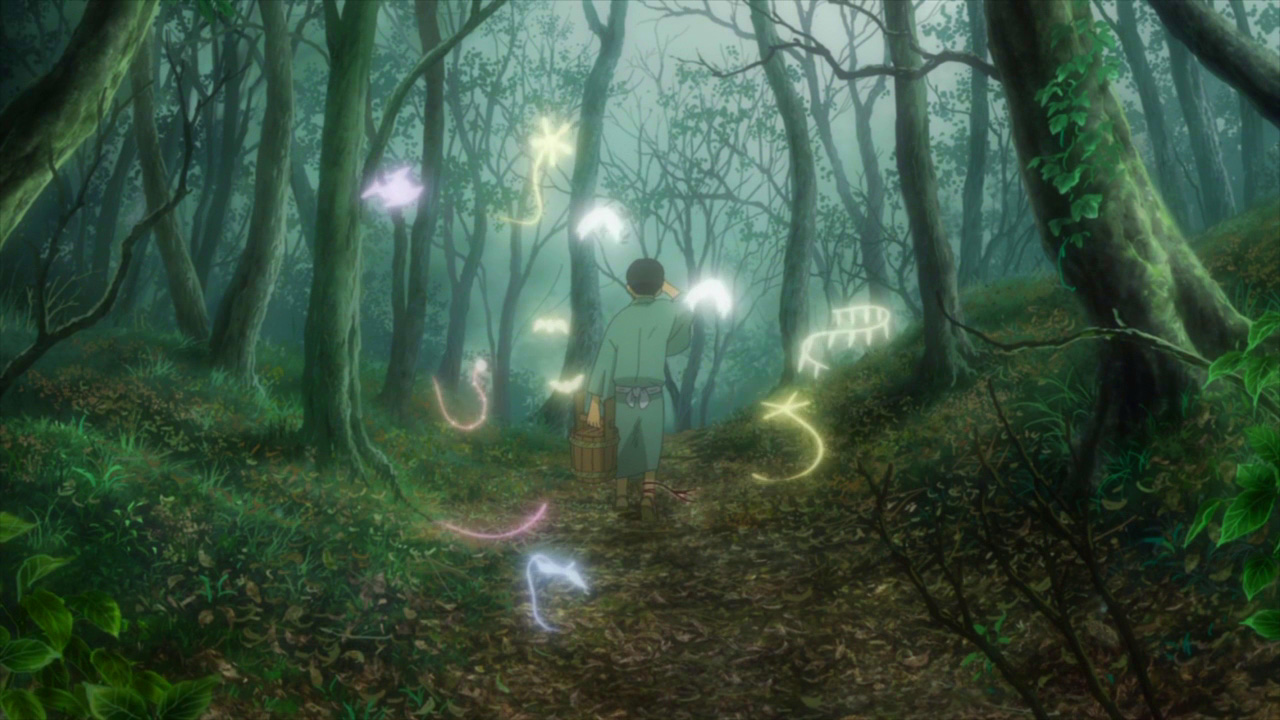
The rise in popularity of fantasy manga and anime during the 20th-century Japanese society changes can be viewed as a similar response to new frustrations. Mushishi’s fantasy acts is one of these responses. Through the manga, readers can engage with their nostalgia for simpler times while also seeing their worries, fears, and unknowns manifested as small supernatural insect-like creatures.
Unlike in their real-life though, they are guided through this familiar but mysterious landscape by Ginko’s wide breadth of knowledge of the world. The audience can feel comforted that, just as the characters in the manga can peacefully coexist alongside Mushi, they too can coexist alongside their own fears and problems.
